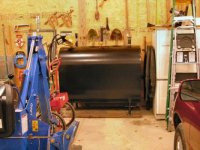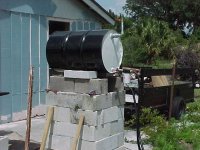PineRidge
Super Member
I used to fill and transport 6 of the plastic fuel jugs but all the juggling, transporting, & lifting got old real fast.
Went out and found a used 275 gallon home heating oil tank and mounted and plumbed it to a 110 volt pump in the pole barn.
I take advantage of off-road bulk pricing when the 275 gallon tank is filled and fueling the TC-40D amounts to backing into the pole barn, starting the electric pump, and waiting for the automatic nozzle to let me know when the tractor tank is full. Yeah I know, lazy.
Anyone need any of the small diesel storage tanks? I got a few lying around not being used.
Went out and found a used 275 gallon home heating oil tank and mounted and plumbed it to a 110 volt pump in the pole barn.
I take advantage of off-road bulk pricing when the 275 gallon tank is filled and fueling the TC-40D amounts to backing into the pole barn, starting the electric pump, and waiting for the automatic nozzle to let me know when the tractor tank is full. Yeah I know, lazy.
Anyone need any of the small diesel storage tanks? I got a few lying around not being used.


